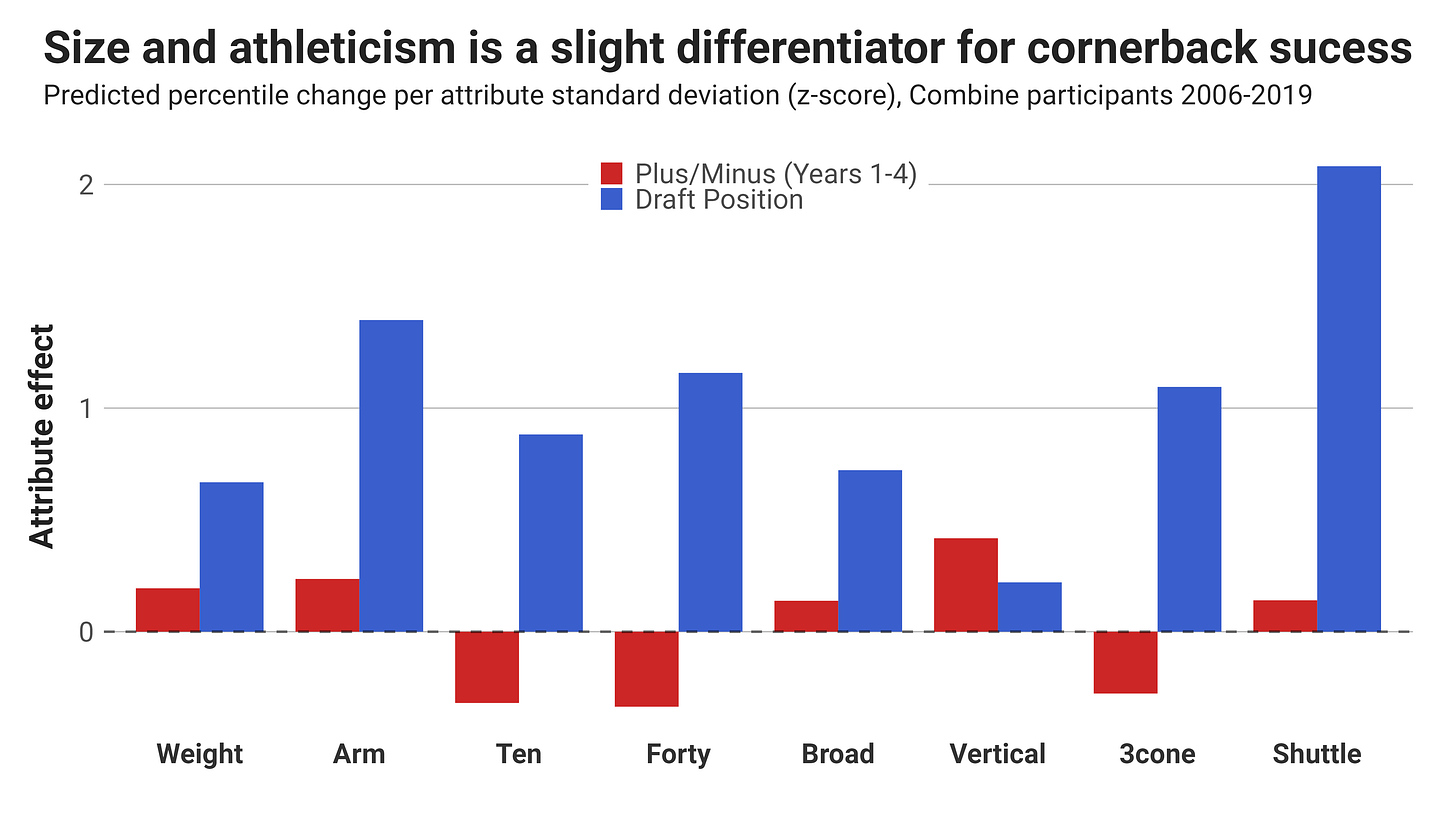Winners and Losers of the NFL Combine: Defensive Backs
Applying modeling based on 15-plus years of combine data to the 2023 NFL draft class
Earlier this week, I released the results of historical modeling on the NFL Scouting Combine since 2006 and quantified the effect of NFL value (according to my Plus/Minus metric) and draft position for all measurements and drills.
In this analysis, I’m going to apply the value models, with a few tweaks, to the results of the 2023 class' combine, focusing on defensive backs, after analyzing defensive linemen yesterday.
In prior analyses, I’ll show an updated illustration for the attribute effect — i.e., the impact of outperformance on early-career Plus/Minus (first four seasons) and NFL draft position. For players who derive the vast majority of their Plus/Minus value from coverage, the effect of the combine is understated. This analysis will be more useful for predicting which players will rise in the draft post-combine, rather than those who will be values in the draft. To avoid confusion, I didn’t include the Plus/Minus percentiles, which will only confuse the analysis as the correlations are so weak between Plus/Minus and combine results.
CORNERBACKS
The combine results will move draft position for almost all drills, with teams preferring bigger, faster and quicker players (I know, shocking for the NFL).
The correlations between drills and actually NFL value (Plus/Minus) is negligible. This doesn’t mean that athleticism doesn’t matter at the position as much as the cornerbacks who proved themselves through their play in college and on-tape skills likely have at least met the threshold for NFL athleticism. Later round picks more often can sneak into the draft based on combine results, and then are more likely to fail.
The media focuses a lot on speed, but the agility drills (three cone and shuttle) and pure size (mostly arm length) can be even more important. Only a handful of the 2023 class ran the agility drills. Hopefully we’ll get more complete results through pro days.
The 2023 combine class of cornerbacks is ranked by the percentile of draft effect, meaning how much their results are likely to push up draft position.
Julius Brents has not been mocked in the first round pre-combine, but could get some buzz with his 99th percentile draft score. Some teams might like to see more long speed, but his broad jump, three cone and shuttle were the best in the class, and his 34-inch arms will also attraction positive attention.
According to data collected by Grinding the Mocks, Christian Gonzalez pre-combine had the best average weighted mock score among cornerbacks, and his combine performance shouldn’t do anything to dissuade teams from taking a hard look at him by at least the middle of the first round. The same goes for Joey Porter Jr., who was a bit slower in the forty at 4.46 seconds, but had a very strong 1.5 second 10-yard split, the longest arms of the class and scored well on the explosion drills (vertical and broad).
Clark Phillips III is the one player who has been mocked at all in the first round of the NFL draft pre-combine who didn’t perform well according to my draft model. In fact, he had the lowest percentile (4th) of any cornerback who at least ran the 40-yard dash. Phillips has the second shortest arms in the class, and his 4.51 forty doesn’t look great at only 184 pounds.
SAFETIES
Safeties are similar to cornerback as primarily deriving value from coverage, with more of a focus on run defense. Size and speed have even larger attribute effects on NFL draft position than for corners, but there isn’t much signal for NFL value according to Plus/Minus.
This wasn’t a great set of combine results for the 2023 safety class with none scoring over the 75th percentile in draft score. That said, there will probably be at least a few names from the cornerback table above who end up playing snaps at safety in the NFL, adding better athleticism to the pool.
Far and way the highest mocked safety according to Grinding the Mocks has been Brian Branch to this point in the offseason. Now you’ll see that branch isn’t in the table below, since he was officially listed as a cornerback on the NFL’s combine website. Branch had a bottom 20th percentile for cornerbacks, and would have only been slightly better among safeties (25th percentile).
Daniel Scott is a name to watch to see how much he moves up based on the combine results. His draft percentile was only third at 65th, but he ran all the drills, and scored exceptionally well in the three cone and shuttle, especially considering his 208-pound frame.






